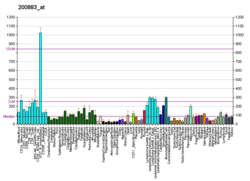UQCRC2
Cytochrome b-c1 complex subunit 2, mitochondrial (UQCRC2), also known as QCR2, UQCR2, or MC3DN5 is a protein that in humans is encoded by the UQCRC2 gene.[5] The product of UQCRC2 is a subunit of the respiratory chain protein Ubiquinol Cytochrome c Reductase (UQCR, Complex III or Cytochrome bc1 complex), which consists of the products of one mitochondrially encoded gene, MTCYTB (mitochondrial cytochrome b) and ten nuclear genes: UQCRC1, UQCRC2, Cytochrome c1, UQCRFS1 (Rieske protein), UQCRB, "11kDa protein", UQCRH (cyt c1 Hinge protein), Rieske Protein presequence, "cyt. c1 associated protein", and "Rieske-associated protein."[6][7] Defects in UQCRC2 are associated with mitochondrial complex III deficiency, nuclear, type 5.[5]
Structure
UQCRC2 is located on the p arm of chromosome 16 in position 12.2 and has 14 exons.[5] The UQCRC2 gene produces a 48.4 kDa protein composed of 453 amino acids.[8][9] UQCRC2 belongs to the peptidase M16 family and UQCRC2/QCR2 subfamily. UQCRC2 has a transit peptide domain. Ubiquinol Cytochrome c Reductase (b-c1 complex) contains 11 subunits: 3 respiratory subunits (cytochrome b, cytochrome c1 and Rieske/UQCRFS1), 2 core proteins (UQCRC1/QCR1 and UQCRC2/QCR2) and 6 low-molecular weight proteins (UQCRH/QCR6, UQCRB/QCR7, UQCRQ/QCR8, UQCR10/QCR9, UQCR11/QCR10 and a cleavage product of Rieske/UQCRFS1).[10][11] UQCRC2 is part of the hydrophobic core of the b-c1 complex and is necessary for the stabilization of Ubiquinol Cytochrome c Reductase.[12]
Function
The protein encoded by this gene is located in the mitochondrion, where it is part of the ubiquinol-cytochrome c reductase complex (also known as complex III). This complex constitutes a part of the mitochondrial respiratory chain.[5] The core protein UQCRC2 is required for the assembly and stabilization of the complex.[10][11]
Clinical Significance
Variants of UQCRC2 have been associated with mitochondrial complex III deficiency, nuclear, type 5.[5] Mitochondrial complex III deficiency nuclear type 5 is a disorder of the mitochondrial respiratory chain resulting in a highly variable phenotype depending on which tissues are affected. Clinical features include mitochondrial encephalopathy, psychomotor retardation, ataxia, severe failure to thrive, liver dysfunction, renal tubulopathy, muscle weakness, exercise intolerance, lactic acidosis and hypoglycemia. Homozygous mutations resulting in a change from Arginine to Tryptophan at position 183 have been associated with mitochondrial complex III deficiency due to UQCRC2 dysfunction. Autosomal recessive inheritance has been proposed as a transmission pattern.[12][13][14]
Interactions
UQCRC2 has 98 protein-protein interactions with 90 of them being co-complex interactions. CAC1A, QCR1, UQCRC1, CACNA1A, STOM, a8k1f4, HLA-B, ARF6, and Mapk3 have been found to interact with UQCRC2.[10][11][15]
References
- GRCh38: Ensembl release 89: ENSG00000140740 - Ensembl, May 2017
- GRCm38: Ensembl release 89: ENSMUSG00000030884 - Ensembl, May 2017
- "Human PubMed Reference:". National Center for Biotechnology Information, U.S. National Library of Medicine.
- "Mouse PubMed Reference:". National Center for Biotechnology Information, U.S. National Library of Medicine.
- "Entrez Gene: UQCRC2 ubiquinol-cytochrome c reductase core protein II".
- Duncan AM, Ozawa T, Suzuki H, Rozen R (November 1993). "Assignment of the gene for the core protein II (UQCRC2) subunit of the mitochondrial cytochrome bc1 complex to human chromosome 16p12". Genomics. 18 (2): 455–6. doi:10.1006/geno.1993.1500. PMID 8288258.
- Hosokawa Y, Suzuki H, Toda H, Nishikimi M, Ozawa T (August 1989). "Complementary DNA encoding core protein II of human mitochondrial cytochrome bc1 complex. Substantial diversity in deduced primary structure from its yeast counterpart". The Journal of Biological Chemistry. 264 (23): 13483–8. PMID 2547763.
- Zong NC, Li H, Li H, Lam MP, Jimenez RC, Kim CS, Deng N, Kim AK, Choi JH, Zelaya I, Liem D, Meyer D, Odeberg J, Fang C, Lu HJ, Xu T, Weiss J, Duan H, Uhlen M, Yates JR, Apweiler R, Ge J, Hermjakob H, Ping P (October 2013). "Integration of cardiac proteome biology and medicine by a specialized knowledgebase". Circulation Research. 113 (9): 1043–53. doi:10.1161/CIRCRESAHA.113.301151. PMC 4076475. PMID 23965338.
- Yao, Daniel. "Cardiac Organellar Protein Atlas Knowledgebase (COPaKB) —— Protein Information". amino.heartproteome.org. Retrieved 2018-07-30.
- "UniProt: the universal protein knowledgebase". Nucleic Acids Research. 45 (D1): D158–D169. January 2017. doi:10.1093/nar/gkw1099. PMC 5210571. PMID 27899622.
- "UQCRC2 - Cytochrome b-c1 complex subunit 2, mitochondrial precursor - Homo sapiens (Human) - UQCRC2 gene & protein". www.uniprot.org. Retrieved 2018-07-30.
- Online Mendelian Inheritance in Man (OMIM): 615160
- Miyake N, Yano S, Sakai C, Hatakeyama H, Matsushima Y, Shiina M, Watanabe Y, Bartley J, Abdenur JE, Wang RY, Chang R, Tsurusaki Y, Doi H, Nakashima M, Saitsu H, Ogata K, Goto Y, Matsumoto N (March 2013). "Mitochondrial complex III deficiency caused by a homozygous UQCRC2 mutation presenting with neonatal-onset recurrent metabolic decompensation". Human Mutation. 34 (3): 446–52. doi:10.1002/humu.22257. PMID 23281071.
- Gaignard P, Eyer D, Lebigot E, Oliveira C, Therond P, Boutron A, Slama A (July 2017). "UQCRC2 mutation in a patient with mitochondrial complex III deficiency causing recurrent liver failure, lactic acidosis and hypoglycemia". Journal of Human Genetics. 62 (7): 729–731. doi:10.1038/jhg.2017.22. PMID 28275242.
- "113 binary interactions found for search term UQCRC2". IntAct Molecular Interaction Database. EMBL-EBI. Retrieved 2018-08-25.
Further reading
- Hosokawa Y, Suzuki H, Toda H, Nishikimi M, Ozawa T (1990). "The primary structure of the precursor to core protein II, a putative member of mitochondrial processing protease family, of rat mitochondrial cytochrome bc1 complex deduced from cDNA sequence analysis". Biochemistry International. 20 (4): 731–7. PMID 2162168.
- Hu WH, Hausmann ON, Yan MS, Walters WM, Wong PK, Bethea JR (April 2002). "Identification and characterization of a novel Nogo-interacting mitochondrial protein (NIMP)". Journal of Neurochemistry. 81 (1): 36–45. doi:10.1046/j.1471-4159.2002.00788.x. PMID 12067236.
- Wen JJ, Garg N (December 2004). "Oxidative modification of mitochondrial respiratory complexes in response to the stress of Trypanosoma cruzi infection". Free Radical Biology & Medicine. 37 (12): 2072–81. doi:10.1016/j.freeradbiomed.2004.09.011. PMID 15544925.
This article incorporates text from the United States National Library of Medicine, which is in the public domain.





